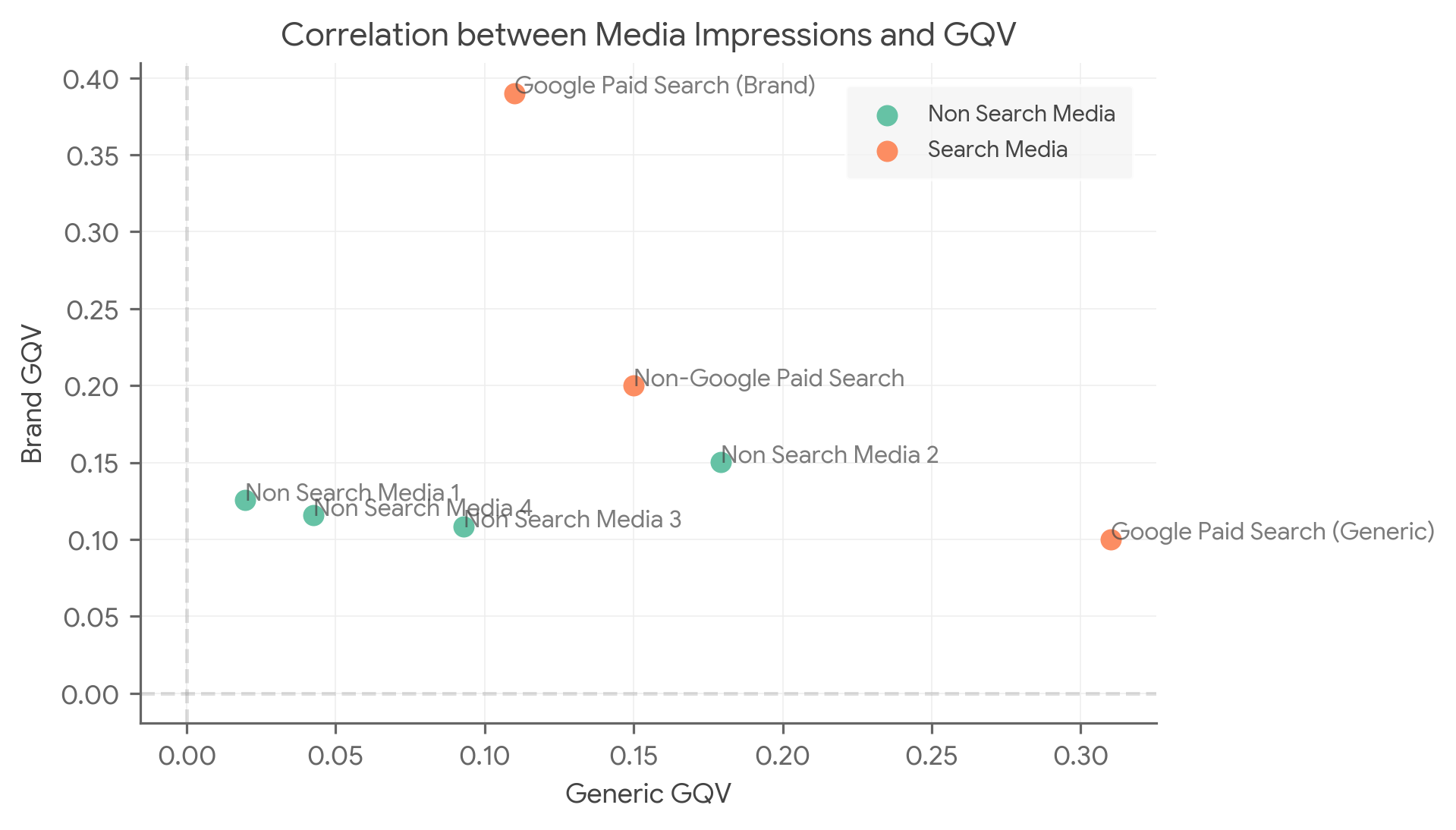Paid Search Data
Google Query Volume (GQV) is often an important confounder between media and sales. This is particularly true for paid search because query volume can drive ad volume under certain campaign settings, such as when the budget cap does not prevent it. When GQV is a confounder, you must control for it to get unbiased causal estimates for any media it confounds with. Failing to control for GQV can lead to overestimation of the causal effect of paid search.
Meridian offers a solution in that GQV data can be included as a control variable. Consider the following recommendations:
It is best to scale GQV data by geo population. This can be done with the
control_population_scaling_idargument.Paid search campaigns that target brand-specific queries are very different from those that target more generic product related queries. It is best to include these campaigns as separate media channels in the model.
Brand-specific keyword campaigns are often modeled using clicks because they are intended to drive direct web traffic. Other campaigns are often modeled using impressions because impressions can be effective even when they don't result in a click.
It is best to include query counts that correspond to the queries targeted by each paid search media channel included in the model. For example, if the MMM includes Brand-specific paid search and Generic paid search as separate media channels, then it is advisable to include Brand-specific GQV and Generic GQV as two separate control variables.
For more detailed considerations, see Including query volume as a control variable.
GQV, paid search, frequency, and other Google-related data for your organization can be obtained from the Google MMM Data Platform. For information about accessing this data, see Use MMM Data Platform.
Using clicks or impressions for search ads
When you are deciding whether to use clicks or impressions for search ads, consider the following:
Deciding between clicks and impressions does have an effect, but there is no consistent perspective across, or even within, measurement partners on which input is best.
As an advertiser, consider what you have more control over. Because the model tells you how media execution (whether defined by clicks or impressions) impacts a KPI, using a variable that you have more control over, in turn, gives you more control over impacting the KPI.
Clicks are more likely to be correlated with the KPI, while impressions are more likely to be correlated with GQV. Brand-specific keyword campaigns are often modeled using clicks because they are intended to drive direct web traffic. Other campaigns are often modeled using impressions because impressions might be effective even when they don't result in a click.
Understanding query volume as a confounder for search ads
Perhaps the biggest challenge in causal inference when applied to marketing is that advertisers often spend more on marketing when there is stronger demand for their product. Disentangling whether an increase in the KPI is due to an increase in marketing spend or due to an increase in inherent demand is a primary concern when one is analyzing causal effects of marketing spend.
The strong relationship between inherent demand and marketing spend is particularly salient when it comes to search ads. This is because a search ad is only shown on the page if a search query matches certain keywords targeted by a set of advertisers. When inherent demand is high, organic query volume will also be high, and so the total spending on search ads will be high. Therefore, organic query volume is an important confounder for search ads. It is hard to get good inference on search ads without it.
This is particularly an issue for advertisers with high search budgets because their paid search ad volume tends to track more closely with organic query volume. However, this also affects lower budget advertisers who increase their budgets during periods of high demand, or who only run search campaigns during these periods.
Meridian provides the option to include Google organic query volume (GQV) in the model as a confounder for Google Search ads. Organic query volume from non-Google search engines is often unavailable. If you want to model non-Google paid search ads, and organic query volume from the corresponding search engine is not available, the following alternatives might work for you:
Bias can be mitigated if GQV is a good proxy for the non-Google query volume. We recommend assessing this assumption. One way to help assess the assumption is by creating a plot, for example:

The previous plot shows the correlation between media impressions and brand GQV on the y-axis, and the correlation between media impressions and generic query volume on the x-axis.
If you don't want to assume GQV is a good proxy for the non-Google query volume, you might need to omit the non-Google search engine from the model.
For more information about the challenges of selection bias due to ad targeting, see Bias Correction For Paid Search In Media Mix Modeling.
